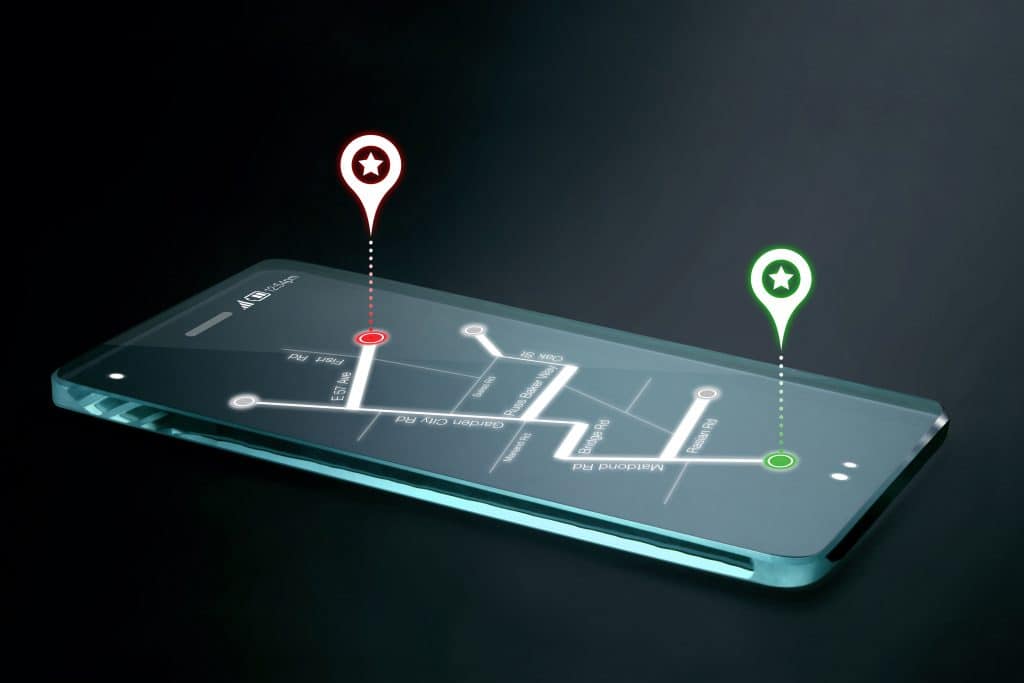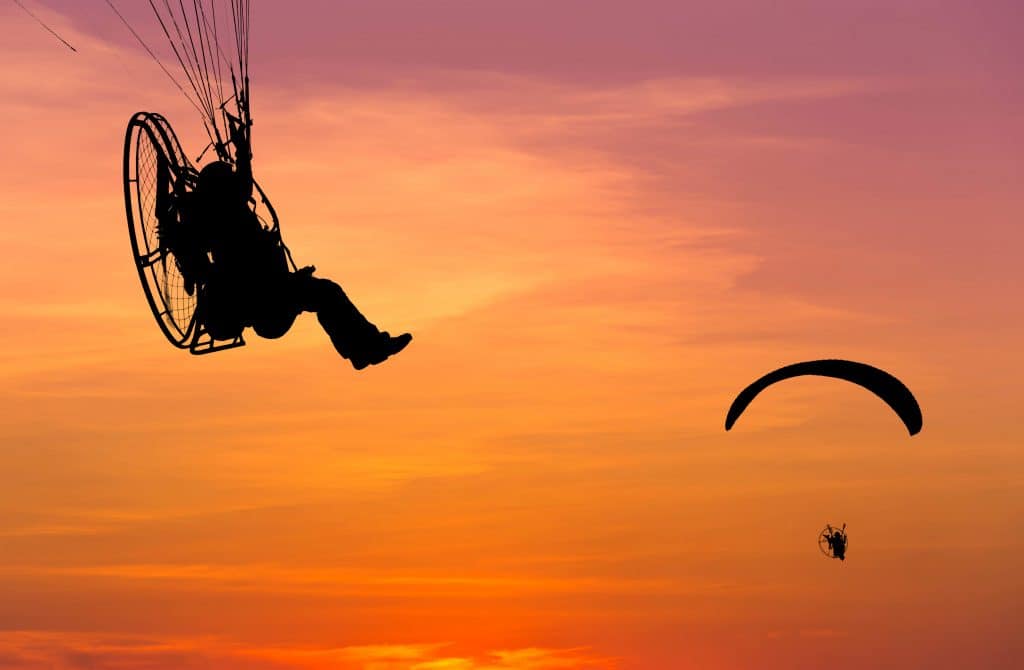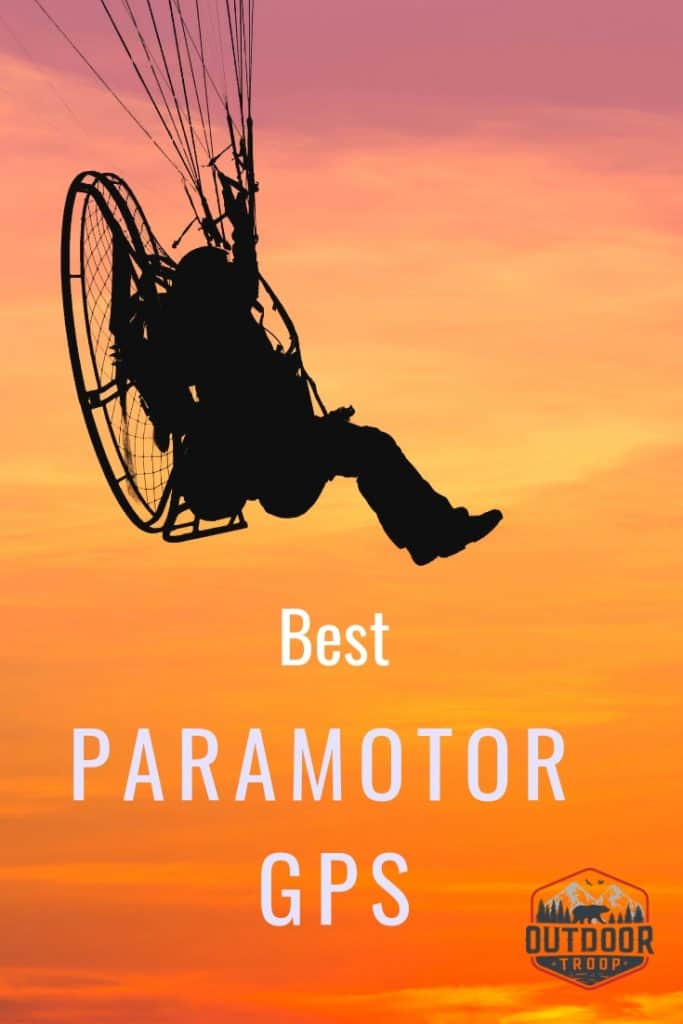
Hello everyone, this post is about GPS. A true modern day miracle, GPS has changed the way we get around. This includes how we get around in the sky. While it is still the law to have visual contact with the ground while flying a paramotor, a GPS can help you track your miles and tracks, and help you if you ever get lost.
So, what is the best paramotor GPS? The Garmin Montana 680 is the all-around best GPS for a paramotor pilot, because it has a touch screen, prominently displays your elevation, and will track your flight path. Although this GPS unit was designed for backpacking, it will work great for a paramotorist.
Even though I consider this the number one choice if money is no object, that does not mean that this is the only GPS that will work for flying! There are several other really good GPS units out there too, available at different price points. In this article, I will explain what you should look for in a paramotoring GPS. Also, for those of you who are cheap like me, I will explain how even your phone can be used as a GPS!
Why a Backpacking GPS?
Basically, as a paramotorist, you will want a GPS unit that is easy to hold during a flight, that is easy to tie and strap to something secure, and that will work once you are off the ground. You need to know your elevation, your speed, where you have been, and where you are going (your heading).
This pretty much means that the Google Maps app on your phone won’t be the ideal way to use GPS technology while in flight. While it is true that mapping apps do use your phone’s built-in GPS, they are not written to capture all of this data that is of interest to a paramotor pilot.
Also, Google Maps (or pretty much any other mapping app) will use an Internet connection to draw the maps for you. Up in the sky and over rural areas, the chances of you having a reliable data connection are slim.
Even if you are flying low to the ground and still have cell signal, all the app could do is tell you where you are. It wouldn’t be able to give you the other data that you need, like your speed, showing where you have been, elapsed flight time, etc. These are key pieces of information that you can only get from a real GPS unit or from a specialized app on your phone.
This is why a GPS unit designed for backpacking comes in so handy in the sky. If you are looking at buying a dedicated GPS unit, then I would recommend getting one of the backpacking types.
They are durable, water-resistant, have good battery life, and have the features you need. They can tell you exactly where you are. Especially for those who are doing cross-country flying, you will be lost after a while if you can’t use a GPS.
These hiking GPS units will show prominently your current elevation. This is probably the single most important piece of information you can have while flying!
Aside from being nice to know, this piece of data is vital. You need to know your elevation to be able to follow the airspace rules and fly safely. This is something that definitely can’t be done with just Google Maps.
These hiking GPS units also keep a record of where you have been. Knowing your flight path is a really nice piece of information to have. Aside from being able to show off to your friends where you were flying, it could actually come in really handy for planning out your trip.
Using a GPS will make it a lot easier to know how many miles you have flown and how much more range you probably have. It will make it a lot easier to see where a good refueling place might be coming up.
These units show you a lot of other geeky statistics that you are always dying to know, such as average speed, average elevation, sunrise and sunset times, etc.
Aside from being a great tool, all of your saved flight data could come in handy for another reason: If you are ever accused of doing anything illegal in the sky, all this saved flight data could actually help you prove your innocence!
Aside from being nice to know, some of this data is vital, and any backpacking GPS unit should do a great job at getting that data for you.
The Garmin Montana 680
I chose the Garmin Montana 680 as #1 because it comes with maps preloaded, has good battery life, and has a huge touchscreen. That big display is great for use while flying.
It is no secret that Garmin is the industry leader in manufacturing quality GPS technology. It is also no secret that their products have the price tag to back up that quality, and this unit is no exception. This guy sells for over $400.
If money is no object though, this is probably the most precise and easiest to read GPS unit out there.
The Next Best One
Garmin has a strong reputation for making equipment that is really accurate and high quality.
If you are looking for another great option from Garmin, but can’t tolerate the $400 price tag, then the Garmin eTrex Touch 35t might be something to look into. It has similar features but sells for about half of what the Montana sells for.
Something Different – The Garmin Foretrex 401
Another GPS that has become popular is the Garmin Foretrex 401. This GPS has a bit of a different design and can be worn as a wristwatch.
On an old-school black and white screen, it shows location data, sunrise and sunset times, and most importantly, your elevation.
The glaring and obvious thing lacking from this GPS is a map. While it does display your coordinates, there is no visual representation of where you are and what is around you, which is one of the most helpful things that a GPS can do for you.
But, selling for $150, it is probably one of the cheapest ways to take advantage of the data that GPS can provide for you.
What to Look for
If you are trying to make a decision about a GPS unit, remember this: all of Garmin’s backpacking models are more or less the same, with the biggest differences being battery life and memory.
Some will have more memory and come with the maps preloaded, and with others, you will need to manually load the maps for the area you will be flying in. I would recommend having plenty of memory. All the other differences are just up to your preference.
These are the most important things that I would look for:
- A touchscreen. This makes it a lot easier to use while flying
- Elevation prominently displayed
- Comes with Tracking
- Durable, water resistant.
- Maps come preloaded, plenty of memory
For our purposes, the battery life concern is less of an issue, because we are not backpacking for days at a time on a single charge. You just want to be sure to find one that will show elevation (which I believe is most if not all of them) and that should really be enough to do the job.
On top of that, it is also really nice to have the location tracking, which is also pretty much every GPS unit designed for backpacking.
This is all you really need, the rest is just up to your preference.
Phone GPS

Now let’s get to the fun part. Can your phone be used as a GPS? Absolutely! You just need the right software. There are lots of great apps out there that will use your phone’s GPS to track your flight paths, your speed, and elevation.
There are some things to know though. The GPS on your phone is not built to be the most precise or reliable. While it generally does a really good job, you can’t bank on it having the same rock-solid reliability of something like a Garmin. What this translates to is this: the elevation these apps give you might be less than exact.
While regular, dedicated GPS units do have some wiggle room in their precision, they do tend to be very close. You should count on any app using your phone’s GPS to have even more wiggle room.
What this all means is that you should leave yourself some space when it comes to flying near controlled airspace or anything else that could put you in danger. I mean, just in general, please, for the love of our sport, just don’t fly anywhere near where you shouldn’t be flying!
PPGPS – App for Paramotorists
This is probably the best app I have found out there for those who want to use their smartphone while paramotoring. The title stands for Powered Paraglider GPS. As of this writing, the app costs $3.50. There is also a free version but that one looks pretty, you know, free.
The app keeps track of all of the stats that a paramotorist would want to know. Using the phone’s GPS, the app displays your current elevation. It also displays your current heading, current ground speed, and elevation.
Aside from these key features, the app will also come in handy for the many other features that come with it.
Map
PPGPS has a map feature. As mentioned before, the maps need an internet connection to work. But, unlike with Google Maps, you can download the maps before your flight while you do have a connection open.
You just have to choose the area where you want the maps for and you will be able to use them without any problems.
Just choose the location and how much detail you want in the maps and it will download them for you. Keep in mind that to have lots of detail, the resulting file download will be very large.
When the app is capable of drawing the map for you, it will draw one up and point out your current location on the map. In addition to showing where you are now, it will also point out your starting location.
If you get far away from where you started and cannot see the starting location on the map anymore, it will instead display the distance required to return to your launch point and how long it would take for you to return back there.
Distance Traveled
Using the GPS, the app will be able to track how far you have traveled, with or without the maps downloaded. The distance traveled and the exact flight path is saved each time you fly.
The data is saved into a file on the phone’s internal storage. Then, these files can be opened up on your computer with Google Maps to look at your flight path.
Time and Sunset

Another box (or “instrument” as the app likes to call them) on the screen is for the elapsed flight time and the sunset time. You can switch between the two by tapping on the box.
The coolest part is that these two values are calculated automatically. Once open, the app detects if you have taken off and starts the elapsed time counter once you have. And once your GPS location is calculated, it will fetch the sunset time for your current latitude, longitude, and time zone.
Wind
The app can tell you which way the wind is blowing, without consulting any weather data! It does this by taking speed samples while you are flying at different headings. To get a good estimation of the wind speed and direction, be sure to fly in a full circle or figure 8.
Make your turn slow enough that the app has time to measure the speed at each heading. The wind direction is represented by the red pointer on the screen.
When looking at the estimated wind speed, remember that it is an average of different data taken at different times.
If you feel that the wind speed has changed, or you want to get a better idea of the true wind direction and speed before landing, you should hit the reset button and fly for a minute to get a good reading of your speed at all of the different headings.
Fuel Gauge
This “instrument” does require some configuration, as the app can’t possibly know your fuel tank size without you telling it. The tank size can be set before takeoff in the Settings menu.
Once you start flying, the app can make a reasonable guess of how much range you have left (based on the distance you have traveled and the wind conditions).
Although this is only a guess, it is pretty nice, and lets you know when you should start thinking about finding a place to land or get back home if you will be landing back at your take-off point.
It’s Your Choice
So to sum up, you should remember: the best GPS depends on your preferences, your needs, and your budget. You can buy the “nicest one,” such as the Garmin Montana 680, with all of the features and reliability of a Garmin, or, if you feel fine with using an app, a smartphone could make do.
Although these devices tell you your calculated elevation, I would also advise using an old school altimeter at all times as well, just to be safe.
When it comes to GPS, you really can’t go wrong, so good luck with your search and happy flying!

Related Questions
How high in the air can a phone communicate with cell towers? It will completely depend on the type of towers, where they are directing their signal, and how powerful they are. At 10,000 feet above the ground, you have virtually no chance of getting a connection. Closer to the ground, it’s all luck, but the signal can exist up to 10,000.
How accurate is the elevation given by a GPS? The elevation from a GPS is accurate to within about 35-70 feet. The accuracy can vary from GPS to GPS depending on the quality of GPS purchased.
